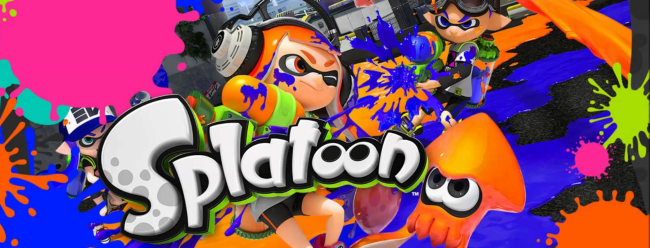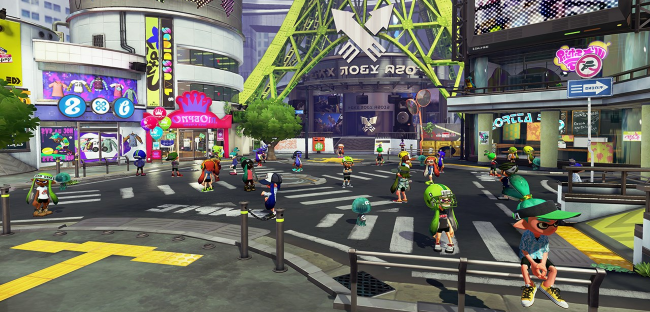
Leave it to Nintendo to take the dullest, iterative and derivative genre of the times and shoot pink ink right in its face. I rarely find a reason to play realistic racing games or hyper-technical fighting games; I could have a much better time playing Mario Kart or Smash Bros. Nintendo knows a fun game trumps an edgy, cool one. Splatoon then, is a fitting take on the crowded online shooter market.
In Splatoon, players control Inklings, humanoid squid-boys and squid-girls. As as inkling, you can run around and shoot ink, or while in squid form, briskly swim through the ink of your own colour. As obtuse of a concept as it may be, it provides an interesting and unique set of mechanics. You can shoot your ink up a wall and swim to the top, or shoot your ink behind an enemy rather than at them, swim through it and attack from behind. Alternating between shooting ink and swimming through it is key to moving quickly. It can be quite an intricate skill-set to master, but the logistic simplicity keeps it easy to understand and learn your way around.
There are a couple of modes in which you can use your cool inky moves, and you’ll access them from Inkopolis. Reminiscent of Destiny or Dragon Ball: Xenoverse, Inkopolis is an explorable hub. The main attraction is the lobby, where multiplayer matches are fought, but there’s plenty more to look at. You can buy clothes to deck out and improve your Inkling (given the store considers you fresh enough), stock up on weapons to change up your strategy, or scan in amiibo to take part in some exclusive challenges.

That’s not all though. Upon following a conspicuous old squid-guy into the sewer, you’ll discover Splatoon’s single-player ‘story mode’. Here, you’ll fight the Octarians – sentient octopus tentacles with robotic weaponry. It’s in these levels that ink-based gameplay is applied in some wickedly creative ways. Shooting a sponge with ink will expand it, and ink-ropes can be traversed in squid form. Levels are fairly short action-platforming style challenges, tasking you with collecting the Zapfish at the end of the level by traversing a series of floating platforms. This set-up, as well as several level design choices, are noticeably similar to Super Mario Galaxy – launching from platform to platform is almost a little on the nose.
Another similarity to Mario in this mode is the hub for accessing levels, and I really appreciated it. You’re thrown into a small area containing three invisible kettles. Ink a kettle to reveal it, and jump inside to begin a level. Complete all three levels and you’ll open a path to a new area with new kettles. I miss this kind of design. To incentivise exploration (and so levels take more than a couple of minutes), levels are scattered with Power Eggs. You can use these to upgrade your story mode gear. Unfortunately these upgrades and this currency are only applicable to this mode, and irrelevant to the RPG aspects elsewhere.

The amiibo challenges are the only additional single player content in Splatoon. These are unfortunately nothing more than twists on other single player levels. Each compatible amiibo tasks you with completing the same set of levels with a different weapon, essentially, rewarding you with gear for your Inkling. If you’re a completionist, you’ll be playing through each level at least four times each. That’s a bummer. More levels would have been awesome, especially given what’s here is so clever and so short-lived. Upon completion, I was hoping for some kind of Mario-style twist with a whole secret half of the game popping out of nowhere, but I just had to set my sights on multiplayer.
In Turf War, the main gameplay mode, Inklings compete to cover a stage in their teams coloured ink. Changing the target from the opponent to the environment opens up a breadth of strategy. Do you rush to the middle of the battlefield to try and cover some enemy territory, or stay at your spawn point and make sure home-base is totally soaked? It helps that the map is shown on the gamepad at all times, so you can see what your teammates are up to and what areas need attention. If someone’s in a sticky situation, you can even tap their location on the gamepad to launch straight to them. Once the ink-bath concludes, an aerial view of the map is displayed and the area each team covered is revealed. A lot of the time, it’s impossible to tell the winner without seeing the numbers, which just goes to show how important each shot of ink can be.

The other playable multiplayer mode is Splat Zones, which can only be played in Ranked Matches. Splat Zones is a king of the hill type deal. One or two (depending on the level) areas need to be covered in your teams ink to countdown a timer. If your team hits zero you win. Of course getting everyone to battle in the same place creates a much more intense game mode, and different strategies are encouraged. Hiding in ink within the Splat Zone lets you deal with any contestants that may arise, whereas shooting into the area from afar is much safer and more lucrative.
Only two stages are available to play at one time in either game mode; which two will cycle every few hours. Why? Who could say. Each arena encourages distinctly different strategies. For example, whenever I play on Blackbelly Skatepark I head straight for the middle; there’s a tall ramp in the middle from which loads of ground can be painted. Of course this means this position is the most contested and, therefore, dangerous place to be too. Some stages point the teams straight at each other, whereas others have a few spokes to go out and cover. Some have wide, open areas, others are more close-quarters, so different weapons work best on different stages.

As well as the normal Shooters, Inklings can try their hands at using Rollers and Chargers. Rollers are great for covering a lot of ground and taking down enemies up close, whereas Chargers are snipers, requiring paced, accurate shots. Each plays significantly differently from the others. On top of primary weapons, each Inkling has a sub-weapon – usually some type of grenade or mine, and a special weapon – an ability usable when enough ground is covered. As you earn experience and money through games, you’ll be able to buy new sets to bring into battle. Unfortunately, you can not adjust your load-out while waiting for a game, only before joining.
Splatoon is a distinctly Nintendo looking and sounding game. Team colours are matched to create a beautiful mess, environments have personality, and character designs are recognisable, and practically iconic already. Miiverse posts are displayed as graffiti around each stage, and seeing players’ art and jokes is cool and often hilarious. It’s definitely the best Miiverse integration I’ve seen yet. On the downside, the jump animation – specifically while in Inkopolis – is totally weird.
I’d describe the music, on the other hand, as something of a cross between Crash Twinsanity and Metal Gear Rising. Punky riffs and fast-paced melodies, paired with strange and whimsical squid noises. It’s exactly the kind of music I’d expect Inklings to listen to, and it adds great context. I’ve been humming squid noises for days. Not an ordinary thing.

The main criticism I can make of Splatoon is that it lacks substantial content. That said, Nintendo have been transparent with their plans to flesh out the game over time, and have already added a map and entire game mode since launch. Whether this support remains steady or falls short remains to be seen, and will completely shape the lasting quality of the game. The lack of at least optional voice chat may be a misstep, but Nintendo need to get parents on side. I’m sick of news reports about Minecraft being bad for kids because they can talk to strangers through it, so I can’t blame them.
I would be remiss to not mention Wii U connectivity issues. Certain routers will NOT let you play multiplayer. It’s a hardware issue that has plagued previous Wii U games, but Splatoon is perhaps the first to rely fully on internet connectivity. If you’re unable to configure DMZ, you’re not going to be able to play on that connection. Trust me, I messed around with port forwarding for a long time.
 A fresh, fun idea
A fresh, fun idea
 Distinctive map and weapon strategies
Distinctive map and weapon strategies
 Surprisingly robust single player mode
Surprisingly robust single player mode
 Charming characters and world
Charming characters and world
 No loadout changing between matches
No loadout changing between matches
 Restricted maps
Restricted maps
 A bit low on content
A bit low on content
Splatoon is the freshest Nintendo game AND competitive shooter I’ve played for a long time. So long as Nintendo keeps the free content coming, this is a fun time worth having. It’d be nice to be able to play more than two maps at any time, to change weapons on the fly, or just skip the ‘news’ video that plays every time you’re in Inkopolis. Compared to how much fun painting the world can be though, these are petty complaints.
EDITOR NOTE: this game was purchased at retail by the writer, and reviewed on Wii U across 15 hours of gameplay.











